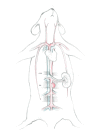Biodegradable Magnesium Stent Treatment of Saccular Aneurysms in a Rat Model - Introduction of the Surgical Technique
- PMID: 28994804
- PMCID: PMC5752359
- DOI: 10.3791/56359
Biodegradable Magnesium Stent Treatment of Saccular Aneurysms in a Rat Model - Introduction of the Surgical Technique
Abstract
The steady progess in the armamentarium of techniques available for endovascular treatment of intracranial aneurysms requires affordable and reproducable experimental animal models to test novel embolization materials such as stents and flow diverters. The aim of the present project was to design a safe, fast, and standardized surgical technique for stent assisted embolization of saccular aneurysms in a rat animal model. Saccular aneurysms were created from an arterial graft from the descending aorta.The aneurysms were microsurgically transplanted through end-to-side anastomosis to the infrarenal abdominal aorta of a syngenic male Wistar rat weighing >500 g. Following aneurysm anastomosis, aneurysm embolization was performed using balloon expandable magnesium stents (2.5 mm x 6 mm). The stent system was retrograde introduced from the lower abdominal aorta using a modified Seldinger technique. Following a pilot series of 6 animals, a total of 67 rats were operated according to established standard operating procedures. Mean surgery time, mean anastomosis time, and mean suturing time of the artery puncture site were 167 ± 22 min, 26 ± 6 min and 11 ± 5 min, respectively. The mortality rate was 6% (n=4). The morbidity rate was 7.5% (n=5), and in-stent thrombosis was found in 4 cases (n=2 early, n=2 late in stent thrombosis). The results demonstrate the feasibility of standardized stent occlusion of saccular sidewall aneurysms in rats - with low rates of morbidity and mortality. This stent embolization procedure combines the opportunity to study novel concepts of stent or flow diverter based devices as well as the molecular aspects of healing.
References
-
- Molyneux A, et al. International Subarachnoid Aneurysm Trial (ISAT) of neurosurgical clipping versus endovascular coiling in 2143 patients with ruptured intracranial aneurysms: a randomised trial. Lancet. 2002;360(9342):1267–1274. - PubMed
-
- Molyneux AJ, et al. International subarachnoid aneurysm trial (ISAT) of neurosurgical clipping versus endovascular coiling in 2143 patients with ruptured intracranial aneurysms: a randomised comparison of effects on survival, dependency, seizures, rebleeding, subgroups, and aneurysm occlusion. Lancet. 2005;366(9488):809–817. - PubMed
-
- Marbacher S, et al. Intraluminal cell transplantation prevents growth and rupture in a model of rupture-prone saccular aneurysms. Stroke. 2014;45(12):3684–3690. - PubMed
-
- Marbacher S, et al. Loss of mural cells leads to wall degeneration, aneurysm growth, and eventual rupture in a rat aneurysm model. Stroke. 2014;45(1):248–254. - PubMed
Publication types
MeSH terms
Substances
LinkOut - more resources
Full Text Sources
Other Literature Sources
Medical






